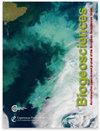西伯利亚东北部针叶林生态系统归一化差异植被指数与土壤湿度的历史变化
IF 3.9
2区 地球科学
Q1 ECOLOGY
引用次数: 0
摘要
摘要西伯利亚东北部的针叶林生态系统是一个气候干燥的永久冻土上的氮限制生态系统,在2007年的极端潮湿事件中发生了变化。研究了1999 - 2019年俄罗斯Spasskaya Pad试验林站土壤水分当量(SWE)、落叶松叶片C/N比、δ13C和δ15N以及环宽指数(RWI)等生态系统参数的归一化植被差异指数(NDVI)作为针叶产量的卫星代用指标,并进行了比较。典型落叶松林(未受影响)与受2007年极端湿事件影响的样地NDVI的历史变化差异较大,因为在极端湿事件发生前,受影响样地的树木死亡率很高,导致NDVI下降,而典型落叶松林与受2007年极端湿事件影响样地的NDVI没有差异。2007年以前,典型落叶松森林NDVI与swed呈显著正相关,与叶片C/N呈显著负相关。这些结果表明,除了前一个夏季和今年6月的水分有效性(高SWE)外,土壤氮有效性也可能增加针叶产量。NDVI与RWI也正相关,这是由相似的因素控制的。湿事件发生后,NDVI与SWE呈负相关,而NDVI与叶片arc /N呈负相关。这些结果表明,湿事件发生后,高土壤水分有效度降低了针叶产量,这可能是由于氮有效度降低所致。2007年以前叶片δ15N与ndvip呈显著正相关,2007年湿润事件后叶片δ15N呈下降趋势。这一结果表明,由于极高的土壤湿度,对根系造成损害和/或土壤氮动态变化。西伯利亚东北部的针叶林作为一个干旱的森林生态系统,不仅受到温度引起的干旱的影响,还受到土壤高湿度(由极端潮湿事件引起)和氮动力学的影响。本文章由计算机程序翻译,如有差异,请以英文原文为准。
Historical variation in the normalized difference vegetation index compared with soil moisture in a taiga forest ecosystem in northeastern Siberia
Abstract. The taiga ecosystem in northeastern Siberia, a nitrogen-limited
ecosystem on permafrost with a dry climate, changed during the extreme wet
event in 2007. We investigated the normalized difference vegetation index
(NDVI) as a satellite-derived proxy for needle production and compared it
with ecosystem parameters such as soil moisture water equivalent (SWE),
larch foliar C/N ratio, δ13C and δ15N, and ring
width index (RWI) at the Spasskaya Pad Experimental Forest Station in Russia
for the period from 1999 to 2019. Historical variations in NDVI showed a
large difference between typical larch forest (unaffected) and the sites
affected by the extreme wet event in 2007 because of high tree mortality at
affected sites under extremely high SWE and waterlogging, resulting in a
decrease in NDVI, although there was no difference in the NDVI between
typical larch forest and affected sites before the wet event. Before 2007,
the NDVI in a typical larch forest showed a positive correlation with SWE
and a negative correlation with foliar C/N. These results indicate that not only the water availability (high SWE) in the previous summer and current
June but also the soil N availability likely increased needle production.
NDVI was also positively correlated with RWI, resulting from similar factors
controlling them. However, after the wet event, NDVI was negatively
correlated with SWE, while NDVI showed a negative correlation with foliar
C/N. These results indicate that after the wet event, high soil moisture
availability decreased needle production, which may have resulted from lower
N availability. Foliar δ15N was positively correlated with NDVI
before 2007, but foliar δ15N decreased after the wet event.
This result suggests damage to roots and/or changes in soil N dynamics due
to extremely high soil moisture. As a dry forest ecosystem, taiga in
northeastern Siberia is affected not only by temperature-induced drought but
also by high soil moisture (led by extreme wet events) and nitrogen
dynamics.
求助全文
通过发布文献求助,成功后即可免费获取论文全文。
去求助
来源期刊

Biogeosciences
环境科学-地球科学综合
CiteScore
8.60
自引率
8.20%
发文量
258
审稿时长
4.2 months
期刊介绍:
Biogeosciences (BG) is an international scientific journal dedicated to the publication and discussion of research articles, short communications and review papers on all aspects of the interactions between the biological, chemical and physical processes in terrestrial or extraterrestrial life with the geosphere, hydrosphere and atmosphere. The objective of the journal is to cut across the boundaries of established sciences and achieve an interdisciplinary view of these interactions. Experimental, conceptual and modelling approaches are welcome.
 求助内容:
求助内容: 应助结果提醒方式:
应助结果提醒方式:


